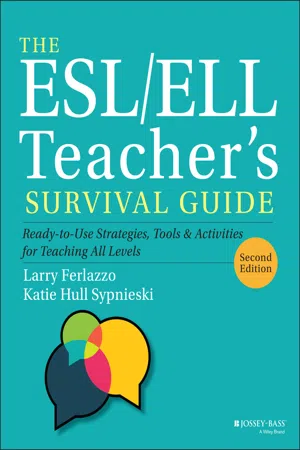
The ESL/ELL Teacher's Survival Guide
Ready-to-Use Strategies, Tools, and Activities for Teaching All Levels
- English
- ePUB (mobile friendly)
- Available on iOS & Android
The ESL/ELL Teacher's Survival Guide
Ready-to-Use Strategies, Tools, and Activities for Teaching All Levels
About this book
Maximize the educational potential of your ESL/ELL class with this singular resource
The ESL/ELL Teacher's Survival Guide: Ready-to-Use Strategies, Tools, and Activities for Teaching English Language Learners of All Levels, 2nd Edition offers readers a comprehensive range of instructional strategies and educational resources for teaching English. The newly revised 2nd Edition includes brand new chapters on:
- Working with Long-Term English Language Learners
- Teaching English internationally
- Teaching Elementary Age ELLs
- Teaching Adult ELLs
- Teaching ELLs with learning challenges
- Culturally Responsive Instruction
- Effective online instruction
- Working with co-teachers and para-professionals
In addition to the new chapters, The ESL/ELL Teacher's Survival Guide contains updated material on topics including math, science, social studies, Common Core Standards, the Next Generation Science Standards and 150 pages of new, highly engaging content. An essential resource for anyone involved in teaching English as a Second Language to students of all ages, this book is perfect for general education teachers and ESL specialists for students in grades six through twelve. It's also highly instructive for teachers of adult ESL classes, elementary and teacher educators, and resource specialists.
Frequently asked questions
- Essential is ideal for learners and professionals who enjoy exploring a wide range of subjects. Access the Essential Library with 800,000+ trusted titles and best-sellers across business, personal growth, and the humanities. Includes unlimited reading time and Standard Read Aloud voice.
- Complete: Perfect for advanced learners and researchers needing full, unrestricted access. Unlock 1.4M+ books across hundreds of subjects, including academic and specialized titles. The Complete Plan also includes advanced features like Premium Read Aloud and Research Assistant.
Please note we cannot support devices running on iOS 13 and Android 7 or earlier. Learn more about using the app.
Information
PART ONE
Getting Started with English Language Learners
CHAPTER ONE
ELL Instruction: The Big Picture
ELL Population Growth
Table of contents
- Cover
- Table of Contents
- Praise for The ESL/ELL Teacher’s Survival Guide
- Title Page
- About the Authors
- Acknowledgments
- About the Contributors
- Introduction
- PART ONE: Getting Started with English Language Learners
- PART TWO: Teaching Beginning English Language Learners
- PART THREE: Teaching Intermediate English Language Learners
- CHAPTER SIX: Daily Instruction for Intermediate ELLs
- PART FOUR: Teaching English Language Learners in the Content Areas
- PART FIVE: Working with Specific Groups of English Language Learners
- PART SIX: Further Strategies to Ensure Success
- Afterword
- Index
- End User License Agreement